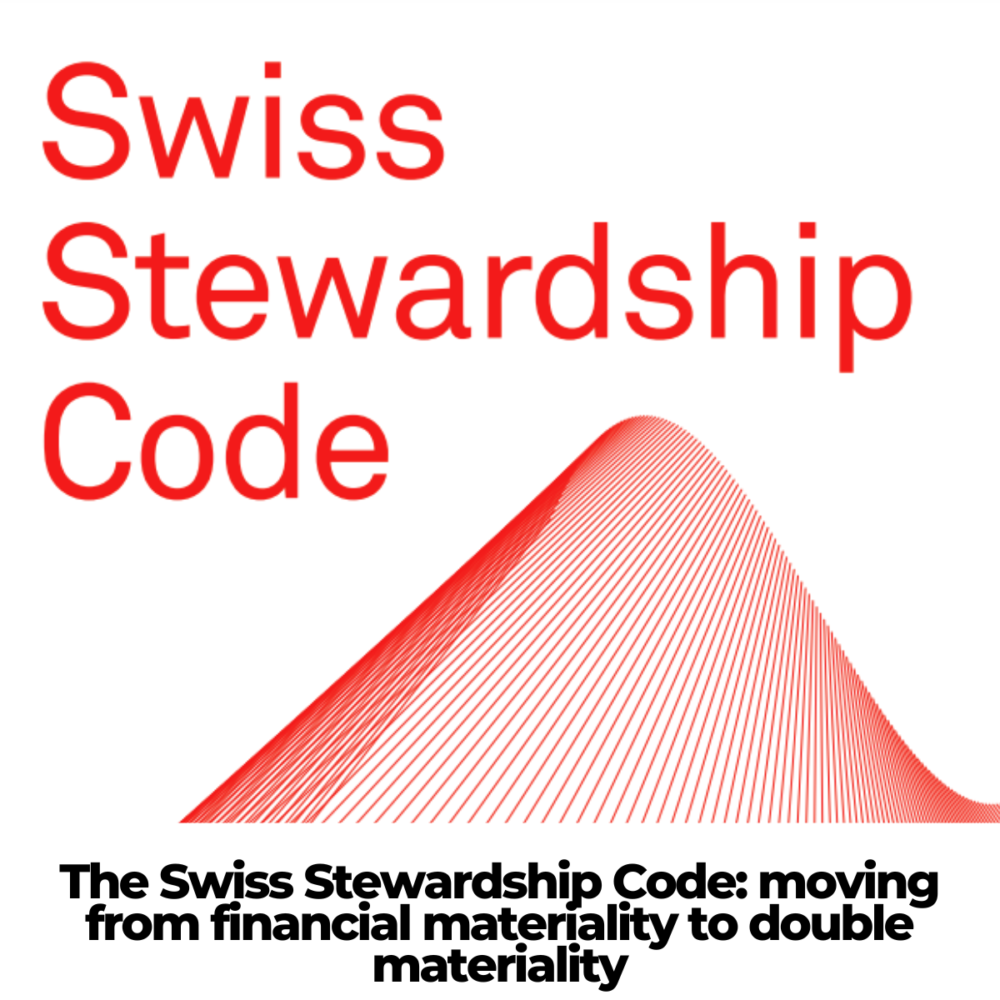
The Swiss Stewardship Code: moving from financial materiality to double materiality
On October 4, the Asset Management Association Switzerland (AMAS) and Swiss Sustainable Finance (SSF) published the Swiss Stewardship Code. In the form of nine principles, the Code lays out a framework to facilitate positive-impact investments.
- Stewardship in the context of sustainability
Stewardship (or active ownership) is an internationally recognized approach to fostering sustainable and responsible investment. The Swiss Stewardship Code defines stewardship as “a responsible investment approach by which investors collaborate and interact with investee entities to generate long-term financial, environmental and societal value, and to reach positive and long-term sustainable outcomes”.[1]
Stewardship initiatives at the international level or developed abroad include the work produced by the Principles for Responsible Investment (UNPRI)[2], the materials published by the International Corporate Governance Network (ICGN)[3], as well as frameworks developed in the European Union and in other jurisdictions.[4] A number of these tools served as models and inspiration for drafting the Swiss Stewardship Code.
Stewardship is also one of the measures advocated by the Federal Council in its report on sustainable finance of December 2022.[5] In particular, the Federal Council has recommended that financial institutions and pension funds disclose on their website to what extent their engagement strategy and the exercise of their shareholder voting rights are compatible with the sustainability goals voluntarily supported by them, specifically the goal of net zero by 2050 (Measure 5 of the Report).
The Swiss Stewardship Code should enable Swiss financial institutions and pension funds to implement stewardship strategies that will enable them to move closer to their sustainability pledges.
- Scope of the Swiss Stewardship Code
The Swiss Stewardship Code provides for a set of recommendations intended for the following stakeholders: asset owners, asset managers and third-party service providers. The latter category refers to specialized third parties to whom asset owners or asset managers (i.e., investors) delegate their stewardship activities (e.g., voting at general meetings, engaging with investee companies or triggering escalation procedures).
It contains recommendations in the form of nine complementary principles that can be grouped into three categories:
- Framework principles: Governance, Stewardship Policies, Delegation of Stewardship Activities and Conflicts of Interest – This category groups together the topics that should be taken into account in any stewardship strategy to establish an effective and transparent framework.
- Stewardship Activities: Voting, Engagement and Escalation – The second category addresses what is at the heart of a stewardship strategy since it concerns the means to be used to pursue positive impact objectives.
- Monitoring and Reporting: Monitoring of Investee Entities and Transparency and Reporting – This last category includes the monitoring measures (towards investees and service providers and within the investors themselves) required to ensure that the implementation of the agreed stewardship strategy is in line with the objectives pursued and, where necessary, that corrective measures can be taken.
Therefore, through nine principles relatively detailed, yet leaving sufficient leeway, the Swiss Stewardship Code lays the foundations for implementing effective stewardship strategies.
- A step towards the acknowledgement of double materiality of and future challenges
Recent developments in sustainable finance in Switzerland have so far focused mainly on two aspects: disclosure requirements and the notion of ESG-related financial risk.
Increased transparency and the integration of ESG risks into the investment decision-making process are key issues for investors as well as financial markets. However, the transition to a more sustainable economy that is compatible with net-zero emissions objectives requires a more active approach throughout the investment process.
The Swiss Stewardship Code stands out by providing a framework for investors and service providers to implement long-term investment policies that aim to achieve positive change. We are thus moving from an approach focused on the financial materiality of ESG considerations to one that integrates the issue of creating positive impact (double materiality). In this respect, the Swiss Stewardship Code can only be welcomed.
As with any non-binding recommendation, the future challenge is for this Code to be implemented by all relevant stakeholders, so that effective stewardship policies can be achieved.
[1] Swiss Stewardship Code, October 2023, p. 6.
[2] See the resources available on the UNPRI website.
[3] See the resources available on the ICGN website.
[4] E.g., the EFAMA Stewardship Code, UK Stewardship Code, Singapore Stewardship Principles, Taiwan Stewardship Principles for Institutional Investors, Canadian Stewardship Code, Hong Kong Principles of Responsible Ownership, Netherlands Stewardship Code, US Stewardship Framework for Institutional Investors. These resources can be accessed from the ICGN website.
[5] Sustainable finance in Switzerland Areas for action for a leading sustainable financial centre, 2022–2025, Federal Council Report, December 16, 2022.
Your contacts at OBERSON ABELS SA
Antoine Amiguet
T +41 58 258 88 88
Philipp Fischer
T +41 58 258 88 88
Sonia De la Fuente



